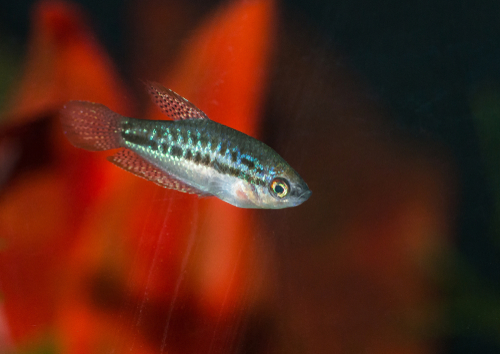Sparkling Gouramis, also called Pygmy Gouramis, are docile, delicately iridescent, and thrive with other tiny and placid species in a community tank. Sparkling Gouramis are super compatible with multiple different kinds of tank mates with a similar temperament.
According to many aquarium experts, the best Sparkling Gourami tank mates include small tetras like embers and tetras, rasboras, yoyo loaches, or minnows.
Here are the best Sparkling Gourami friends to keep in a community tank.
Contents
The Best Sparkling Gourami Tank Mates
1. Pearl Gourami

- Scientific name: Trichopodus leerii
- Origin: Thailand, Indonesia, and Malaysia
- Size: 5 inches:
- Care: Easy
The shimmering Pearl Gourami has a flat silhouette with a black stripe through its body and pearly-white dots that look like lace or a mosaic. That’s why these fish are also known as Lace or Mosaic Gourami.
Since Lace Gouramis are shoaling fish, they do well when housed with other kinds of Gouramis or non-aggressive species.
Given the right water parameters, vegetation, and diet that includes black worms, blood worms, and brine shrimp, Pearl Gouramis are happy to spend most of their time tucked into plants, rocks, or crevices.
Pros of Keeping With Sparkling Gourami
- Mellow mood, easy to care for, and handle
Cons of Keeping With Sparkling Gourami
- May become susceptible to fin rot
2. Ember Tetra
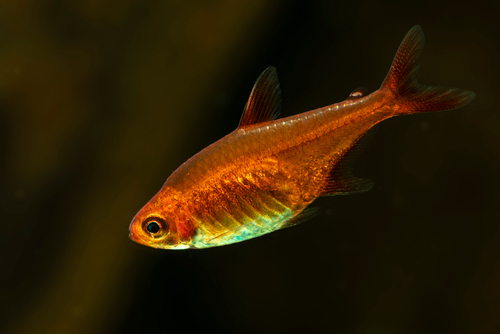
- Scientific name: Hyphessobrycon amandae
- Origin: Brazil
- Size: 1 or 2 inches
- Care: Easy
A tank with lots of thick vegetation is the best environment for an Ember Tetra. Given placid water and the right tank conditions, this tiny, vivid orange or red-colored fish can live up to four years.
Their shy, placid, and playful behavior makes them fun aquarium pets. Once they are comfortable in a tank, Ember Tetras tend to shoal in groups and have active and interesting swimming patterns.
While they don’t have a complicated diet, it’s important to ensure that you feed them balanced and good-quality food that’s broken down to an appropriate size. This will help Ember Tetras manage each mouthful and help them keep their vibrant color.
Pros of Keeping With Sparkling Gourami
Gentle, playful, and easy for beginners to handle
Cons of Keeping With Sparkling Gourami
Susceptible to color fading and weak immunity
3. Neon Tetra
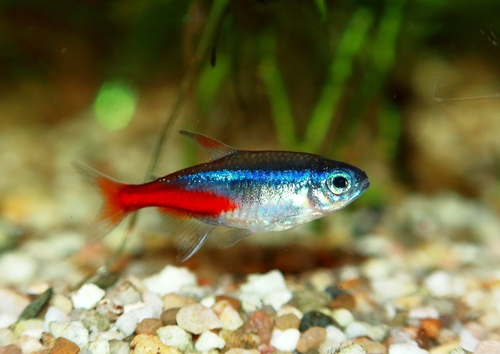
- Scientific name: Paracheirodon innesi
- Origin: Peru, Columbia, and Brazil
- Size: 1 inch
- Care: Easy
Consider buying an active and attractive fish such as Neon Tetras that are compatible with Sparkling Gouramis. These micro-size fish have bold blue, red, and white patterns that can inject life into any tank. Neons are not only non-aggressive, but they also are super easy for beginners to care for.
Add lots of thick plants, and floating vegetation, and use rocks and tank décor to provide hiding places. At the same time, don’t fill the tank entirely with plants and rocks because these schooling fish also need some filtered light and room to swim freely.
They enjoy frozen or live food if it is broken into crumbs that can fit into their tiny mouths. Creating a natural environment and keeping a minimum of 15 Tetras in a tank will reduce stress and help these pretty fish live a long and optimal life.
Pros of Keeping With Sparkling Gourami
- Calm temperament and easy care
Cons of Keeping With Sparkling Gourami
- Light-sensitive, easily stressed, and may have lower immunity
4. Dwarf Gourami
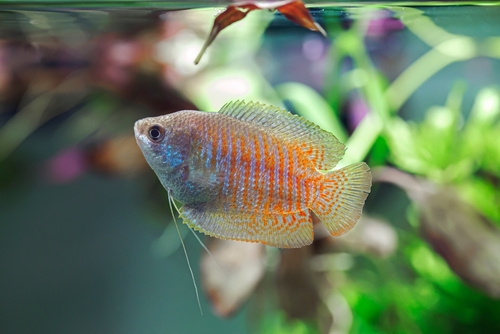
- Scientific name: Trichogaster Ialius
- Origin: Bangladesh, Pakistan, and India
- Size: 4 inches
- Care: Easy
These bright, aquatic gems make fantastic tank mates for their Sparkling Gourami relatives. It also does well with many other types of peaceful freshwater fish. You can choose from many kinds of Dwarf Gourami to add interest to your tank. Some popular kinds include Powder Blue Dwarf Gourami and Flame Dwarf Gourami.
Dwarf Gourami tend to inhabit the middle or upper water area because they need to easily access the water surface for oxygen. While these fish thrive on a basic diet of vegetable flakes and worms, they need regular water changes and precise room temperatures to keep their labyrinth organ in good shape.
Pros of Keeping With Sparkling Gourami
- Calm, social, and easy to feed
Cons of Keeping With Sparkling Gourami
- Requires precise water and room temperature parameters
5. Yoyo Loach
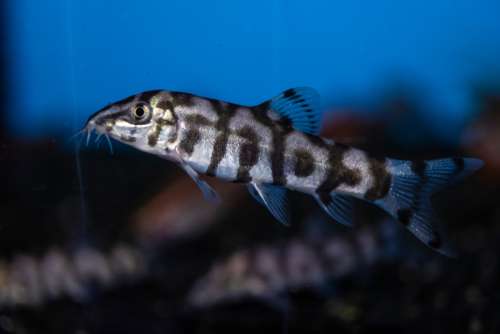
- Scientific name: Botia almorhae
- Origin: India, Pakistan, and Nepal
- Size: 3 inches
- Care: Intermediate to expert
These cool and playful fish are not only striped with black, silver, brown, or yellow like yoyos, but they can hop out of the water over and over just like a yoyo on a string. While Yoyo Loaches have a lot of energy and enjoy putting on a display that’s fun to watch, they aren’t aggressive or territorial to other fish species.
They spend their time in the middle and bottom areas of the tank where they take part in social groups as shoaling fish. As with most freshwater fish, it’s best to include more females than miles to avoid rivalry.
Keep water slightly acidic and add a rock or gravel substrate to mimic the Yoyo Loach’s natural Ganges River habitat. Since Yoyo Loaches are bottom feeders, they eat a lot of worms, snails, larvae, brine shrimp, and vegetable flakes.
Pros of Keeping With Sparkling Gourami
- Social, lively, peaceful, and adaptable to both soft and hard water conditions
Cons of Keeping With Sparkling Gourami
- Can jump at least 6 inches out above the surface of an aquarium. Susceptible to bacterial, parasitical, or fungal infections
6. Harlequin Rasboras
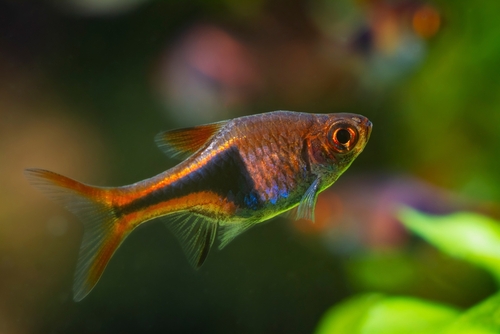
- Scientific name: Rasbora heteromorpha
- Origin: Sumatra, Thailand, Singapore, and Malaysia
- Size: 1 or 2 inches
- Care: Easy
These placid and adaptable tank mates have shiny red or gold bodies with a black oblong triangle pattern near the tail.
They do best in a tank that has a variety of dense vegetation, but access to the top of the tank where they can inhale oxygen. Harlequin Rasboras have a labyrinth organ that lets them breathe air.
As omnivores, Harlequin Rasboras don’t have a complicated diet. Instead, they are perfectly happy consuming frozen food, live worms, brine shrimp, and vegetable pellets.
Pros of Keeping With Sparkling Gourami
- Hardy and adaptable to water conditions, quality, and smaller tanks
Cons of Keeping With Sparkling Gourami
- May become prey for larger fish
7. Otocinclus
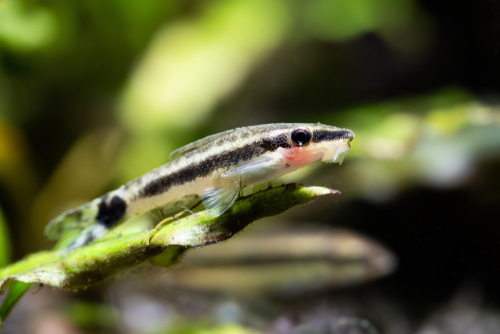
- Scientific name: Otocinclus macrospilus
- Origin: Argentina and Venezuela
- Size: 2 inches
- Care: Easy
Also known as the Dwarf Sucking Catfish, Otocinclus are peaceful little bottom feeders with multicolored bodies and long fins.
Create an environment with lots of plants and nooks and crannies for these small fish to hide. They will scavenge a variety of food such as brine shrimp, bloodworms, algae wafers, blanched lettuce or zucchini, and tubefix worms that make their way to the substrate.
They are active daytime swimmers who need some sunlight and do a great job of cleaning up algae in an aquarium.
Pros of Keeping With Sparkling Gourami
- Non-aggressive and help keep tanks clean
Cons of Keeping With Sparkling Gourami
- Nervous temperament
8. Cory Catfish
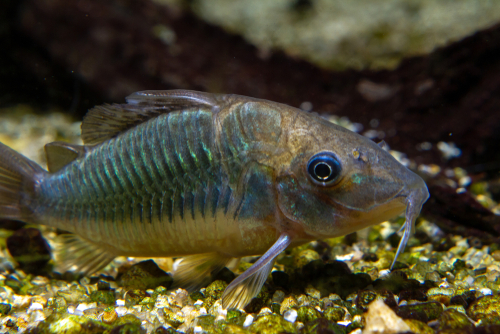
- Scientific name: Brochis splendens
- Origin: Peru
- Size: 1 to 4 inches
- Care: Easy
Another small-size bottom dweller that gets along well with Sparkling Gourami in a community tank is the Cory Catfish. Since they exist near the substrate, they won’t compete with Sparkling Gouramis for space or oxygen at the top of the tank. They can also live for up to twenty years in optimal conditions.
These are schooling fish, so you’ll want to get at least 5 or 6 to keep them happy and watch their group swimming behavior. Choose from different kinds of Cory Catfish such as Panda Cories, Pygmy Cories, Green Cories, or Albino Cory fish.
While they are great algae eaters, Cory Catfish require protein such as shrimp or worms to live their best lives.
Pros of Keeping With Sparkling Gourami
- Peaceful, easy to feed, and care for
Cons of Keeping With Sparkling Gourami
- Requires precise water temperatures
9. Fancy Guppy
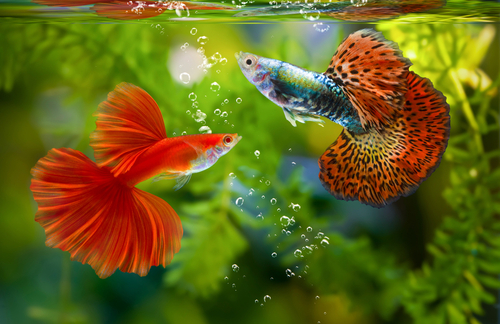
- Scientific name: Poecilia reticulata
- Origin: South America and the Caribbean
- Size: 2 inches
- Care: Easy
With its long, floating fins and dramatic gold, red, black, or blue coloring, a Fancy Guppy is a gorgeous addition to any tank. A Guppy is affordable, a great starter fish, and doesn’t have an aggressive bone in its body.
Create an aquarium that is full of live plants and lots of places to hide. While these fish are easy to take care of, you will need to perform a nitrogen cycle to ensure that the environment is safe before adding any guppies. Their diet includes prepared guppy food, bloodworms, and brine shrimp.
Pros of Keeping With Sparkling Gourami
- Peaceful and easy to care for
Cons of Keeping With Sparkling Gourami
- Prone to parasitic infections
10. Pygmy Corydoras
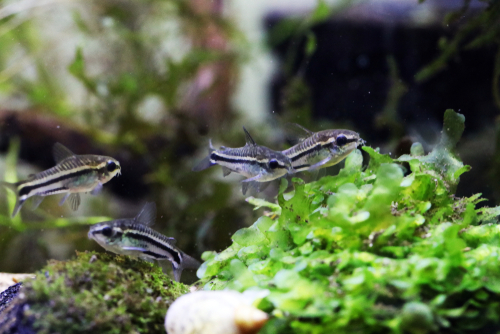
- Scientific name: Corydoras pygmaeus
- Origin: Argentina and Brazil
- Size: 2 inches
- Care: Intermediate
A micro Corydoras is a perfect tank mate for Sparkling Gourami. They’re not only distinctive silvery blue fish with a black central stripe down their bodies, but they’re peaceful bottom feeders who won’t bother your Gouramis at the top of the tank.
Since they’re schooling fish, aim to keep a minimum of 10 pygmies in your aquarium. This will help Corydoras feel more social and enable you to watch their active swimming patterns. They do well on frozen foods like brine shrimp, pellets, or bloodworms if the pieces are tiny enough to swallow.
Pros of Keeping With Sparkling Gourami
- Great for keeping tanks clean
Cons of Keeping With Sparkling Gourami
- Prone to stir up substrate or move plants around
11. Honey Gourami
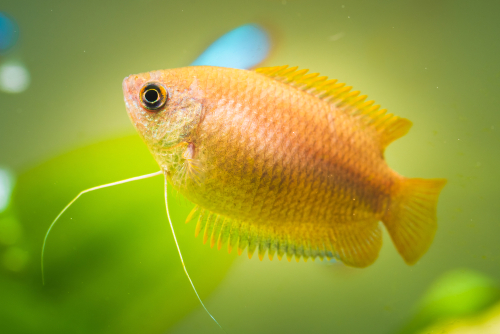
- Scientific name: Trichogaster chuna
- Origin: Bangladesh, India, Brazil, Peru, and Columbia
- Size: 2 inches
- Care: Easy
This fish is a good option for a community nano tank that also contains Sparkling Gourami.
It’s a beautiful fish with a rich golden color and a scale pattern that looks similar to a honeycomb. Some varieties may have orange, red, or olive-brown scales.
Since Honey Gouramis come from rivers that have lots of dense, natural vegetation, it’s important to ensure that you put many live plants in an aquarium to provide filtered light, hiding places, and lots of zooplankton and insect larvae to eat.
Pros of Keeping With Sparkling Gourami
- Easy to maintain & adaptable
Cons of Keeping With Sparkling Gourami
- None
12. Scarlet Badis
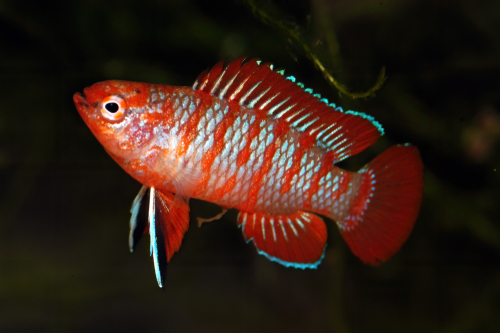
- Scientific name: Dario dario
- Origin: India, Bangladesh, and China
- Size: Less than 1 inch
- Care: Intermediate
If you’re looking for a stunning Sparkling Gourami tank mate, look no further than the Scarlet Badis. Males have the most visually striking scale colors and patterns. These fish have shimmering silver bodies with vertical red or orange bands that start close to the front dorsal fin. Their caudal fin can give a flickering effect when swimming through the water.
Make sure to add a lot of different live plants to the tank to mimic this fish’s natural habitat. Proper water parameters and a meaty protein diet will help this fish live a long and healthier life.
Pros of Keeping With Sparkling Gourami
- Docile
Cons of Keeping With Sparkling Gourami
- Has strict water cleanliness parameters and needs tank cleaning each week
13. Platy Fish
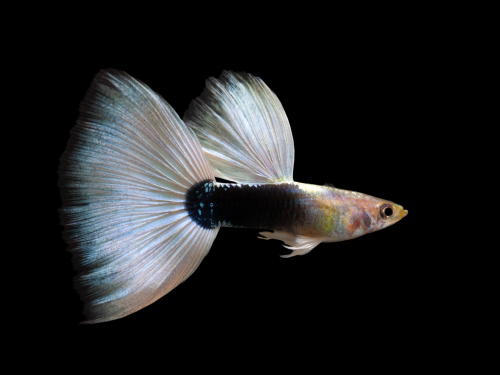
- Scientific name: Poecilia
- Origin: Belize, Guatemala, and Mexico
- Size: 3 inches
- Care: Easy
The docile Platy fish has a gorgeous wash of golden-orange color across its body, red cheek marks, and black freckles that fan out toward a delicate black tail fin. There are many varieties of platy fish with various colors and patterns, so it’s up to you to choose your favorite.
These omnivores enjoy any food that’s provided but thrive on a mix of fish flakes, frozen foods, and live foods.
Pros of Keeping With Sparkling Gourami
- Low Maintenance
Cons of Keeping With Sparkling Gourami
- Semi-short lifespan (average of 3 years)
14. Cherry Shrimp
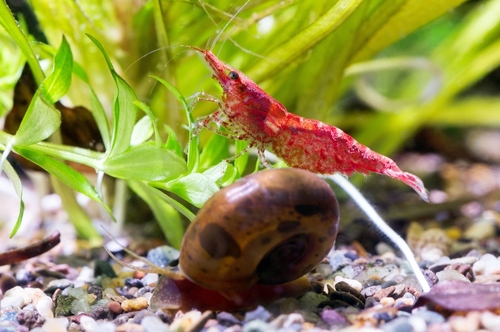
- Scientific name: Neocaridia davidi
- Origin: Japan, Taiwan, and Hawaii
- Size: 1 inch
- Care: Easy
A bright red cherry shrimp is a low-maintenance way to give a Sparkling Gourami a colorful and peaceful tank mate.
Cherry Shrimp don’t bother other fish and spend most of their time cleaning algae off aquarium glass. They also pick up leaf litter from live plants without uprooting them.
Pros of Keeping With Sparkling Gourami
- Adaptable and a good tank cleaner
Cons of Keeping With Sparkling Gourami
- They don’t live long
15. White Cloud Mountain Minnow
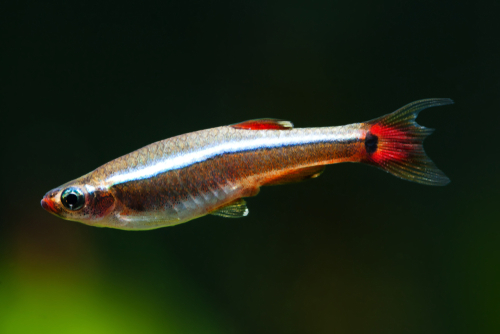
- Scientific name: Tanichthys albonubes
- Origin: China
- Size: 1 inch
- Care: Easy
Despite their small size, these tiny silver fish stand out in a community tank with their crimson tail and black horizontal stripe that runs the length of their bodies.
They are easy for beginner aquarists and have a simple diet that includes little chunks of vegetable pellets and tiny shrimp.
Pros of Keeping With Sparkling Gourami
- Hardy and docile
Cons of Keeping With Sparkling Gourami
- Risk of strep infections, dropsy, and fin rot
Conclusion
There are many small species of freshwater fish that get along well with Sparkling Gouramis. Many of them are shoaling fish that have peaceful temperaments and prefer to keep to themselves.
Providing enough tank space, checking that the water temperature and pH parameters match your fish’s needs, offering a variety of appropriate foods, and mimicking natural environments can ensure that everyone is happy in your community tank.

Ian Sterling, founder of Fishlab.com, began his aquarium journey over 30 years ago, driven by a deep fascination for fish and their diverse personalities. His website, Fishlab.com, is dedicated to making fishkeeping accessible and enjoyable, offering beginner-friendly guidance, expert insights, and a community for aquarists to connect and share experiences.


